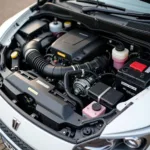Who isn’t fascinated by things small and compact? In the world of cars, this fascination often leads to the question: What’s the Smallest Car In The World? But what exactly makes a car “small,” and what are the limits of what’s technically possible?
What Does “Small” Mean in Automotive Engineering?
“Small” is relative, especially in the context of vehicles. The size of a car usually refers to its dimensions: length, width, height. However, weight and turning radius also play a role in classifying a car as “small.” For many car enthusiasts and experts, like Dr. Ing. Hans Meyer from the renowned Institute for Automotive Technology in Munich, it’s about more than just numbers: “A truly small car must not only be compact but also impress with clever use of space and innovative design solutions.”
 Peel P50, a classic microcar known as the world's smallest production car
Peel P50, a classic microcar known as the world's smallest production car
The Record Holder: The Peel P50
Indeed, a true classic holds the record for the world’s smallest car: the Peel P50. This tiny speedster, produced on the Isle of Man in the 1960s, measures just 134 cm in length and 99 cm in width. Weighing only 59 kg, it’s lighter than some refrigerators and can even be pushed backward thanks to a handle at the rear – a detail that’s beneficial not just for finding parking spaces.
The Challenges of Minimalism in Automotive Engineering
Developing microcars like the Peel P50 is a technical challenge. Every component must be accommodated in minimal space without compromising safety or functionality. Motorization and power transmission also require innovative solutions to ensure adequate driving behavior.
Advantages of Microcars
Despite the challenges, microcars offer some unbeatable advantages:
- Maneuverability in City Traffic: Narrow streets and crowded parking garages are no problem for microcars.
- Lower Fuel Consumption: Reduced weight and compact engines ensure economical use of gasoline or electricity.
- Lower Purchase Costs: Microcars are generally cheaper to buy than their larger counterparts.
 A microcar easily maneuvering through busy city traffic
A microcar easily maneuvering through busy city traffic
Modern Interpretations of the Microcar Concept
Automotive manufacturers today are still inspired by the idea of the microcar. Electric cars like the Renault Twizy or the Citroën Ami show that compact city cars still have their place in the 21st century. They score points with modern powertrains, intelligent connectivity options, and contemporary design.
Conclusion: More Than Just a Niche Product
The trend towards second or third cars and growing environmental awareness could bring microcars back into sharper focus in the future. They are not just a practical alternative for city traffic but also a symbol of sustainable mobility and efficient resource utilization.
Do You Have Questions About Your Car?
Our experts at AutoRepairAid.com are happy to help you! Contact us for a free consultation and let our customized solutions convince you.

